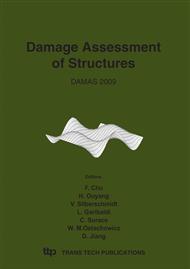p.717
p.725
p.733
p.741
p.749
p.757
p.767
p.775
p.785
Fatigue Safety Evaluation of Existing Reinforced Concrete Bridges
Abstract:
Generally, fatigue has not been considered as a key problem in the design of reinforced concrete bridges. Until the 1960s, reinforcement was mild steel and the stresses permitted in the steel bar and the concrete were such that fatigue and fracture failure was believed to be impossible. With the developments of reinforced concrete structures, higher working stresses were permitted and, in particular, high yield reinforcing bars were introduced. Design rules were issued to control cracking and to prohibit welding of reinforcement unless the risk of fatigue was negligible. In recent years, great deals of researches have been carried out, leading to a better understanding of the fatigue behaviors in concrete structures. Some studies showed that fatigue could occur in reinforced concrete structures in combination with other causes of deterioration. In the past eight years, considerable increases in traffic intensity and wheel loads have caused obviously fatigue damage in reinforced concrete structures in China. Some reinforced concrete bridges were damaged seriously, leading to the whole bridge collapse sometimes because of overloading and oversize trucks. So how to evaluate the fatigue safety of existing reinforced concrete bridges is an urgent problem in China. In the current paper, the assessment models of existing reinforced concrete bridges based on S-N curve and fracture mechanics approach were proposed considering the effect of overloading and oversize trucks. Finally the assessment method based on S-N curve and in-situ monitoring data was applied to a case study bridge.
Info:
Periodical:
Pages:
749-756
Citation:
Online since:
June 2009
Authors:
Price:
Сopyright:
© 2009 Trans Tech Publications Ltd. All Rights Reserved
Share:
Citation:


